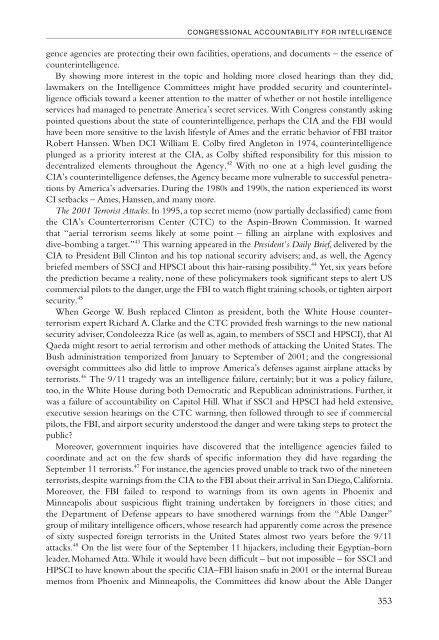Handbook of intelligence studies / edited by
Handbook of intelligence studies / edited by
Handbook of intelligence studies / edited by
Create successful ePaper yourself
Turn your PDF publications into a flip-book with our unique Google optimized e-Paper software.
CONGRESSIONAL ACCOUNTABILITY FOR INTELLIGENCE<br />
gence agencies are protecting their own facilities, operations, and documents – the essence <strong>of</strong><br />
counter<strong>intelligence</strong>.<br />
By showing more interest in the topic and holding more closed hearings than they did,<br />
lawmakers on the Intelligence Committees might have prodded security and counter<strong>intelligence</strong><br />
<strong>of</strong>ficials toward a keener attention to the matter <strong>of</strong> whether or not hostile <strong>intelligence</strong><br />
services had managed to penetrate America’s secret services. With Congress constantly asking<br />
pointed questions about the state <strong>of</strong> counter<strong>intelligence</strong>, perhaps the CIA and the FBI would<br />
have been more sensitive to the lavish lifestyle <strong>of</strong> Ames and the erratic behavior <strong>of</strong> FBI traitor<br />
Robert Hanssen. When DCI William E. Col<strong>by</strong> fired Angleton in 1974, counter<strong>intelligence</strong><br />
plunged as a priority interest at the CIA, as Col<strong>by</strong> shifted responsibility for this mission to<br />
decentralized elements throughout the Agency. 42 With no one at a high level guiding the<br />
CIA’s counter<strong>intelligence</strong> defenses, the Agency became more vulnerable to successful penetrations<br />
<strong>by</strong> America’s adversaries. During the 1980s and 1990s, the nation experienced its worst<br />
CI setbacks – Ames, Hanssen, and many more.<br />
The 2001 Terrorist Attacks. In 1995, a top secret memo (now partially declassified) came from<br />
the CIA’s Counterterrorism Center (CTC) to the Aspin-Brown Commission. It warned<br />
that “aerial terrorism seems likely at some point – filling an airplane with explosives and<br />
dive-bombing a target.” 43 This warning appeared in the President’s Daily Brief, delivered <strong>by</strong> the<br />
CIA to President Bill Clinton and his top national security advisers; and, as well, the Agency<br />
briefed members <strong>of</strong> SSCI and HPSCI about this hair-raising possibility. 44 Yet, six years before<br />
the prediction became a reality, none <strong>of</strong> these policymakers took significant steps to alert US<br />
commercial pilots to the danger, urge the FBI to watch flight training schools, or tighten airport<br />
security. 45<br />
When George W. Bush replaced Clinton as president, both the White House counterterrorism<br />
expert Richard A. Clarke and the CTC provided fresh warnings to the new national<br />
security adviser, Condoleezza Rice (as well as, again, to members <strong>of</strong> SSCI and HPSCI), that Al<br />
Qaeda might resort to aerial terrorism and other methods <strong>of</strong> attacking the United States. The<br />
Bush administration temporized from January to September <strong>of</strong> 2001; and the congressional<br />
oversight committees also did little to improve America’s defenses against airplane attacks <strong>by</strong><br />
terrorists. 46 The 9/11 tragedy was an <strong>intelligence</strong> failure, certainly; but it was a policy failure,<br />
too, in the White House during both Democratic and Republican administrations. Further, it<br />
was a failure <strong>of</strong> accountability on Capitol Hill. What if SSCI and HPSCI had held extensive,<br />
executive session hearings on the CTC warning, then followed through to see if commercial<br />
pilots, the FBI, and airport security understood the danger and were taking steps to protect the<br />
public?<br />
Moreover, government inquiries have discovered that the <strong>intelligence</strong> agencies failed to<br />
coordinate and act on the few shards <strong>of</strong> specific information they did have regarding the<br />
September 11 terrorists. 47 For instance, the agencies proved unable to track two <strong>of</strong> the nineteen<br />
terrorists, despite warnings from the CIA to the FBI about their arrival in San Diego, California.<br />
Moreover, the FBI failed to respond to warnings from its own agents in Phoenix and<br />
Minneapolis about suspicious flight training undertaken <strong>by</strong> foreigners in those cities; and<br />
the Department <strong>of</strong> Defense appears to have smothered warnings from the “Able Danger”<br />
group <strong>of</strong> military <strong>intelligence</strong> <strong>of</strong>ficers, whose research had apparently come across the presence<br />
<strong>of</strong> sixty suspected foreign terrorists in the United States almost two years before the 9/11<br />
attacks. 48 On the list were four <strong>of</strong> the September 11 hijackers, including their Egyptian-born<br />
leader, Mohamed Atta. While it would have been difficult – but not impossible – for SSCI and<br />
HPSCI to have known about the specific CIA–FBI liaison snafu in 2001 or the internal Bureau<br />
memos from Phoenix and Minneapolis, the Committees did know about the Able Danger<br />
353
















